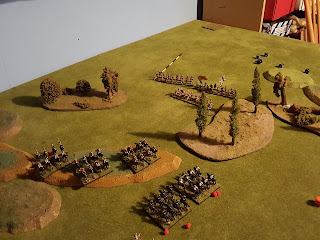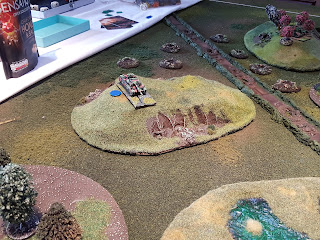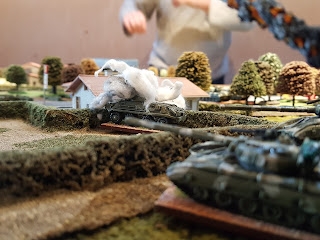Still a great game, and to be honest, I pay scant attention to its 'gamey' nature, each time we play, as it gives a narrative which feels like a real battle.
- It focuses attention where the players want; that said, you can play into this by forcing the opponent to do something he doesn't want to do.
- There are several cards which allow mis-direction and loss of control; it all plays into the narrative, and feels historical. (Command 'Blunders'? It's more than that...)
- The commander's focus dictates what happens; thereby, an entire wing can remain motionless, even as it slowly attempts to feed reinforcements to the main fight, but with great difficulty. Isn't this what we read about?
- The designers of Maurice and Field of Battle have wanted to obtain a narrative, historically playing/sounding action from their rules.
-
Both have been designed to give a historical feel, such that the game is memorable and plays out like a battle narrative.Metaphors? I think where Maurice is the explosive ‘Die Hard’ Movie…there could be sequels, using the same formula, since it works; Field of Battle is a long running series about intelligence operatives, with a convoluted plot arc, where someone is the traitor, yet we don’t find out who until the last episode.…and Slack Chowder is an episode of Eastenders…(or the Gilmore Girls).
Also used my fledgling 15mm forces here. What a great scale, and fits on my 6x4 (site 'B'). I've had these for years, but recently got Stephen #1 to paint most of them for me.
The French left - seems secure.
The Allied centre.
The Allies have the balance of their troops on the right flank, with most of their elites. What are they planning?
Allied moves initially with elite cavalry on their right.
An allied push in the centre, even with 'lethal vollies', will come to naught.
Early artillery action to tray and stem the allied advance, but the focus shifts to the centre.
The Allied left remains static, though both sides feed reinforcements from this flank during the day.
In the centre, allied musket fire ensures severe casualties, but not enough to break the French.
Allied attack through the centre.
Despite shooting away the French guards, the attack falters.
More movement on the Allied right - slow and steady.
Dutch move to the centre in order to prevent its collapse.
French cavalry move to hold their left, which is under threat from elite Allied troops (remember that cavalry?).
Early attacks on the French left go in. The Allies awaiting their infantry.
Good use of cards to maximise and control the narrative.
The battle quickly revolves around the fight on the flank; the French realising that their objective marker remains critically exposed - they now understand the Allied tactic - pulling their troops into a feint in the centre, to create a relatively unopposed flank action!!!
The flank under significant pressure as the battle proceeds.
The French hold on for many turns, but they can do little, having to focus their attention on multiple charges, even trying to bring infantry from the centre.
...but their morale is being eaten away.
...and the allies capture their objective.
A great game, where trying to do too much simply creates panic, and commanders must keep a level head in order to ensure that (1) they focus on the right things and (2) they sacrifice forces where they need to, while preserving units where required. Great game.
Addendum
Sam Mustafa neatly sums up the design intent, in this piece in the FAQ on page 104 of the rulebook:
New players frequently feel 'sucked-in' by game events, becoming focused on some action in one sector of the battlefield, and they feel that they can't risk tearing themselves away from the action for a single round until it reaches a climax, preferably in their favor. When a couple of your units get into a fight, it can be tempting to devote more and more resources to it. But you have to step back and realize that it's usually a better use of those same resources to bring entire large forces into the action instead.
Sometimes you have to let units die. You can't save everybody. There are times when haviong a lot of cards is more important than having any one unit. ('Pass', for instance, even though you're in the thick of a fight.) As you become more experienced, you will learn to pace actions and manage your army.
I still make the mistakes that he refers to, which is the beauty and 'art' of this game. You won't see this sort of discussion in many rule-sets.
Addendum
Sam Mustafa neatly sums up the design intent, in this piece in the FAQ on page 104 of the rulebook:
New players frequently feel 'sucked-in' by game events, becoming focused on some action in one sector of the battlefield, and they feel that they can't risk tearing themselves away from the action for a single round until it reaches a climax, preferably in their favor. When a couple of your units get into a fight, it can be tempting to devote more and more resources to it. But you have to step back and realize that it's usually a better use of those same resources to bring entire large forces into the action instead.
Sometimes you have to let units die. You can't save everybody. There are times when haviong a lot of cards is more important than having any one unit. ('Pass', for instance, even though you're in the thick of a fight.) As you become more experienced, you will learn to pace actions and manage your army.
I still make the mistakes that he refers to, which is the beauty and 'art' of this game. You won't see this sort of discussion in many rule-sets.































































































































